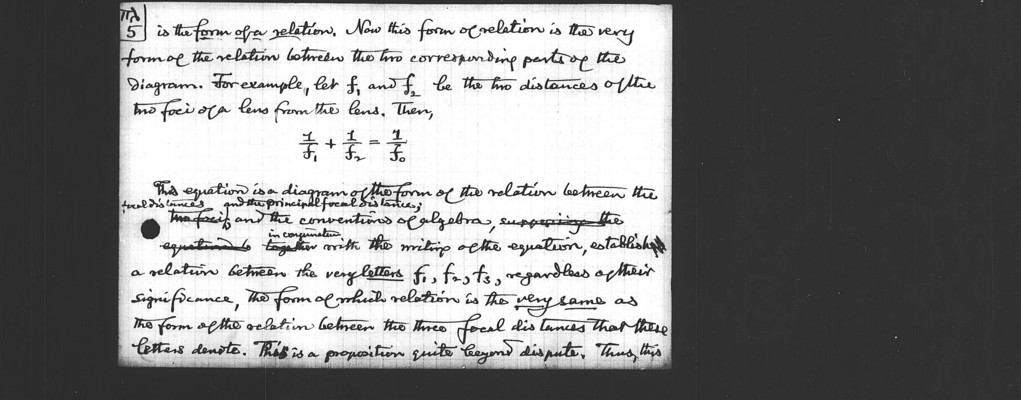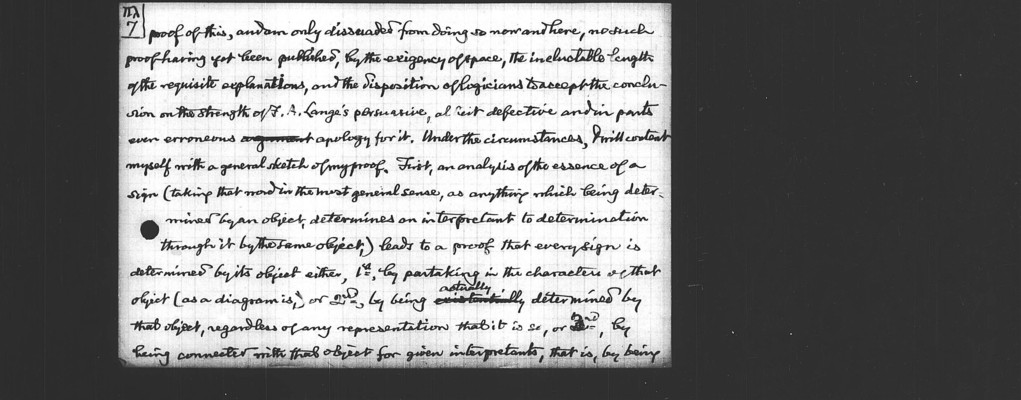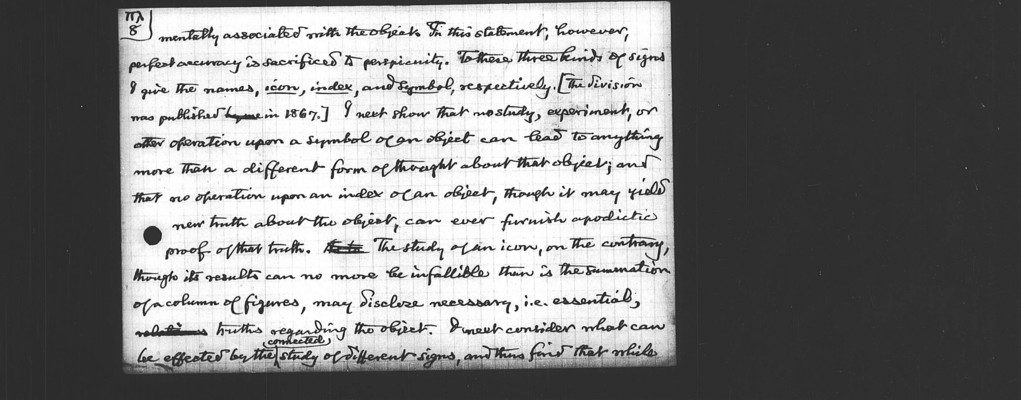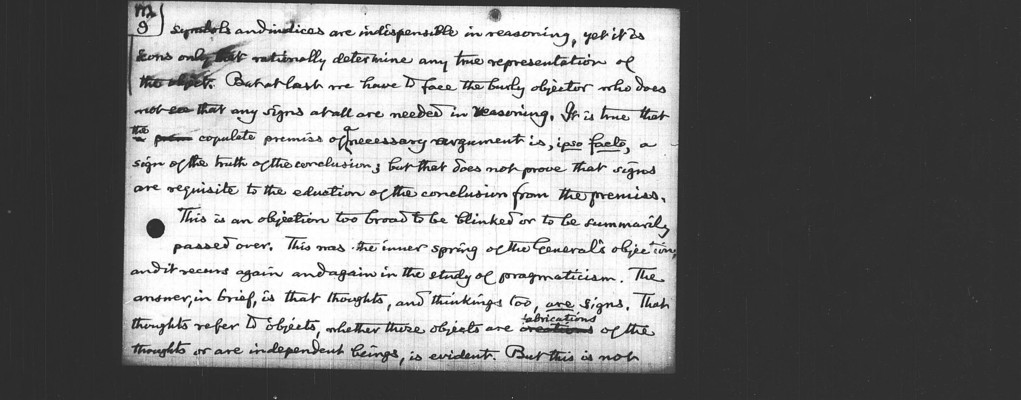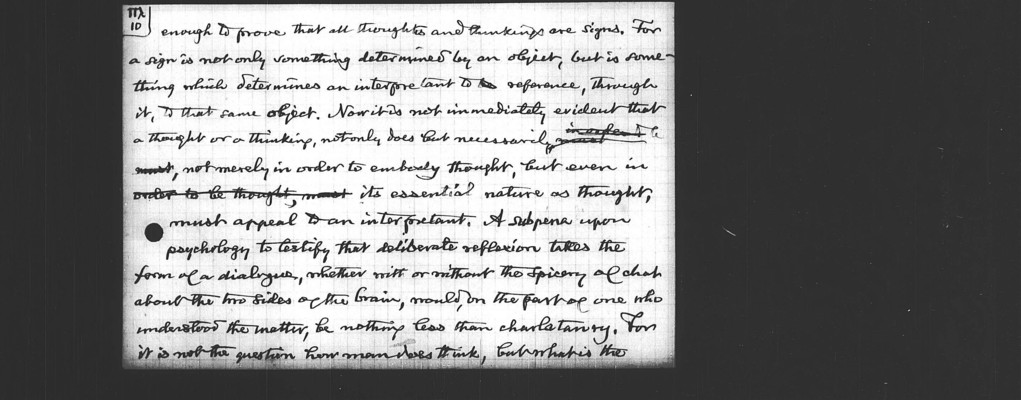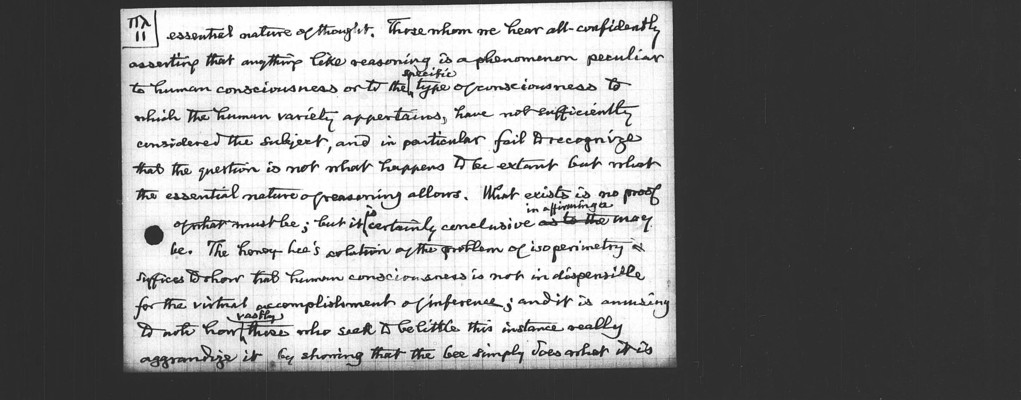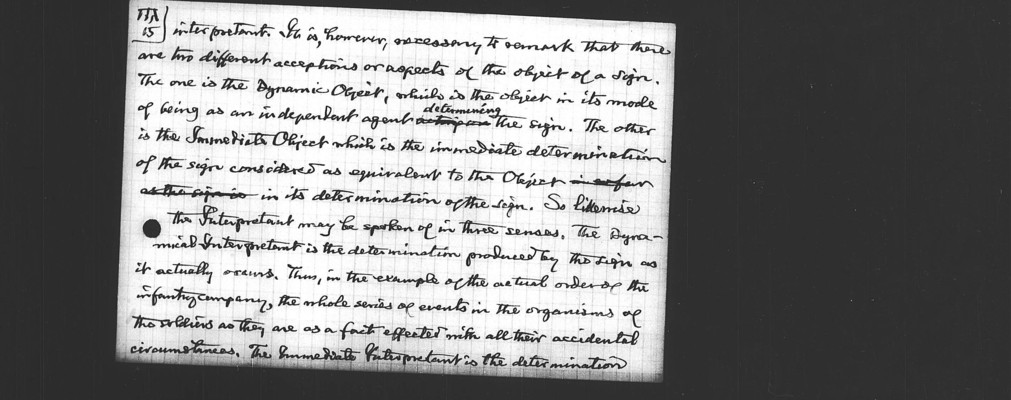Pages That Need Review
MS 292-295 (1906) - Prolegomena to an Apology for Pragmaticism
5
πλ 5 is the form of a relation. Now this form of relation is the very form of the relation between the two corrisponding parts of the diagram. For example, let F, and F2 be the two distances of the two foci of a lens from the lens. Then,
1 + 1 = 1 F F2 F0
This equation is a diagram of the form of the relation between the focal distances and the principal focal distance; two foci, and the conventions of algebra, [Dr?] in [conjunction?] with the writing of the equation, establish a relation between the very letters F1, F2, F3, regardless of their significance, the form of which relation is the very same as the form of the relation between the three focal distances that these letters denote. This is a proposition quite beyond dispute. Thus, this
7
πλ 7
proof of this, and am only dissuaded from doing so now and here, no such proof having yet been published, by the exigency of space, the inelectuable length of the requisite explanations, and the disposition of logicians to accept the conclusion on the strength of J.A. Lange's persuasive, albeit defective and in points even erroneous apology for it. Under the circumstances, I will content myself with a general sketch of my proof. First, an analysis of the essence of a sign (taking that word in the most general sense, as anything which being determined by an object, determines an interpretant to determination through it by the same object) leads to a proof that every sign is determined by its object either, 1st, by partaking in the characters of that object (as a diagram is), or 2nd, by being actually determined by that object, regardless of any representation that it is so, or 3rd, by being connected with that object for given interpretants, that is, by being
8
πλ 8
mentally associated with the object. In this statement, however, perfect accuracy is sacrificed to perspicuity. To these three kinds of signs I give the names, icon, index, and symbol, respectively. (The division was published in 1867.) I next show that no study, experiment, or other operation upon a symbol of an object can lead to anything more than a different form of thought about that object; and that no operation upon an index of an object, though it may yield new truth about the object, can ever furnish apodictic proof of that truth. The study of an icon, on the contrary, though its results can no more be infallible than is the summation of a column of figures, may disclose necessary, i.e. essential, truths regarding the object. I never consider what can be effected by the connected study of different signs, and thus find that while
9
πλ 9
symbols and indices are indispensible in reasoning, yet it is icons only that rationally determine any true representation of the object. But at last we have to face the burly objector who does not see that any signs at all are needed in reasoning. It is true that the complete premiss of a necessary argument is, ipso facto, a sign of the truth of the conclusion; but that does not prove that signs are requisite to the eduction of the conclusion from the premiss. This is an objection too broad to be blinked or to be summarily passed over. This was the inner spring of the Gereral's objection, and it recurs again and again in the study of pragmatism. The answer, in brief, is that thoughts, and thinkings too, are signs. That thoughts refer to objects, whether these objects are fabrications of the thoughts or are independent beings, is evident. But this is not
10
πλ 10
enough to prove that all thoughts and thinkings are signs. For a sign is not only something determined by an object, but is something which determines an interpretant to reference, through it, to that same object. Now it is not immediately evident that a thought or a thinking, not only does but necessarily must, not merely in order to embody thought, but even in its essential nature as thought, must appeal to an interpretant. A subpena upon psychology to testify that deliberate reflexion takes the form of a dialogue, whether with or without the spicery of chat about the two sides of the brain, would, on the part of one who understood the matter, be nothing less than charlatanry. For it is not the question how man does think, but what is the
11
πλ 11
essential nature of thought. Those whom we hear all-confidently asserting that anything like reasoning is a phenomenon peculiar to human consciousness or to the specific type of consciousness to which the human variety appertains, have not sufficiently considered the subject, and in particular fail to recognize that the question is not what happens to be extant but what the essential nature of reasoning allows. What exists is no proof of what must be; but it is certainly conclusive in affirming a may be. The honey bee's solution of the problem of isoperimetry suffices to show that human consciousness is not indispensible for the virtual accomplishment of inference; and it is amusing to note how vastly those who seek to belittle this instance really aggrandize it by showing that the bee simply does what it is
12
πλ 12
mechanically constrained to do, thus drawing attention to the plenum of reason throughout the material universe. Among logical machines none are feebler than those that have been expressly designed as such. The fast yacht is a reasoning machine that solves problems in hydrodynamics far exceeding the powers of the mathematical analysis of our age.
In order to ascertain the relations between thought, thinking, and a sign, it will be necesary to give some defintions of these terms, unsatisfactory though these definitions may be. A sign seems to be connected with a purpose or end. An object may be said to have an end, if it has such a tendency to bring about a certain description of result, that if one mechanism for bringing that result about be pre-
13
πλ 13
vented, this will cause the same sort of result to be brought about by different means. The finality, or tendency to the end, may have different degrees according as the variety of alternative mechanisms or methods of bringing about the final result is greater or less.
A Sign may be defined as something (not necessarily existant) which is so determined by a second something called its Object that it will tend in its turn to determine a third something called its Interpretant in such a way that in respect to the accomplishment of some end [circumscript?] in an effect made upon the interpretant the actual sign is (more or less) equivalent to what that of the Object might have been had the circumstances been different. For example, if an infantry captain
14
πλ 14
drilling his compnay gives the order "Ground arms," the soundwaves of his voice constitute a sign whose object is the captain's will and whose interpretant is the muscular action of his men, this action being substantially the same as if his will had been able directly to control their muscles. Again, that general type of order "Ground arms" whether given by an American officer in Engligh to U.S. soldiers, or given by a Japanese officer in Japanese to Japanese soldiers, (no longer therefore any actual event but only a general type of possible events) is one sign whose single object is whatever officer's will it may be that his soldiers ground arms and whose single interpretant is the type of action of the soldiers conformally to U.S. tactics if it be an American order, but to Japanese tactics if it be a Japanese order is the
15
πλ 15
interpretant. It is, however, necessary to remark that there are two different acceptions or aspects of the object of a sign. The one is the Dynamic Object, which is the object in its mode of being as an independent agent determining the sign. The other is the Immediate Object, which is the immediate determination of the sign considered as equivalent to the Object in its determination of the sign. So likewise the Interpretant may be spoken of in these senses. The Dynamical Interpretant is the determination produced by the sign as it actually occurs. Thus, in the example of the actual order of the infantry company, the whole series of events is the organisms of the soldiers as they are as a fact effected with all their accidental circumstances. The Immediate Interpretant is the determination
